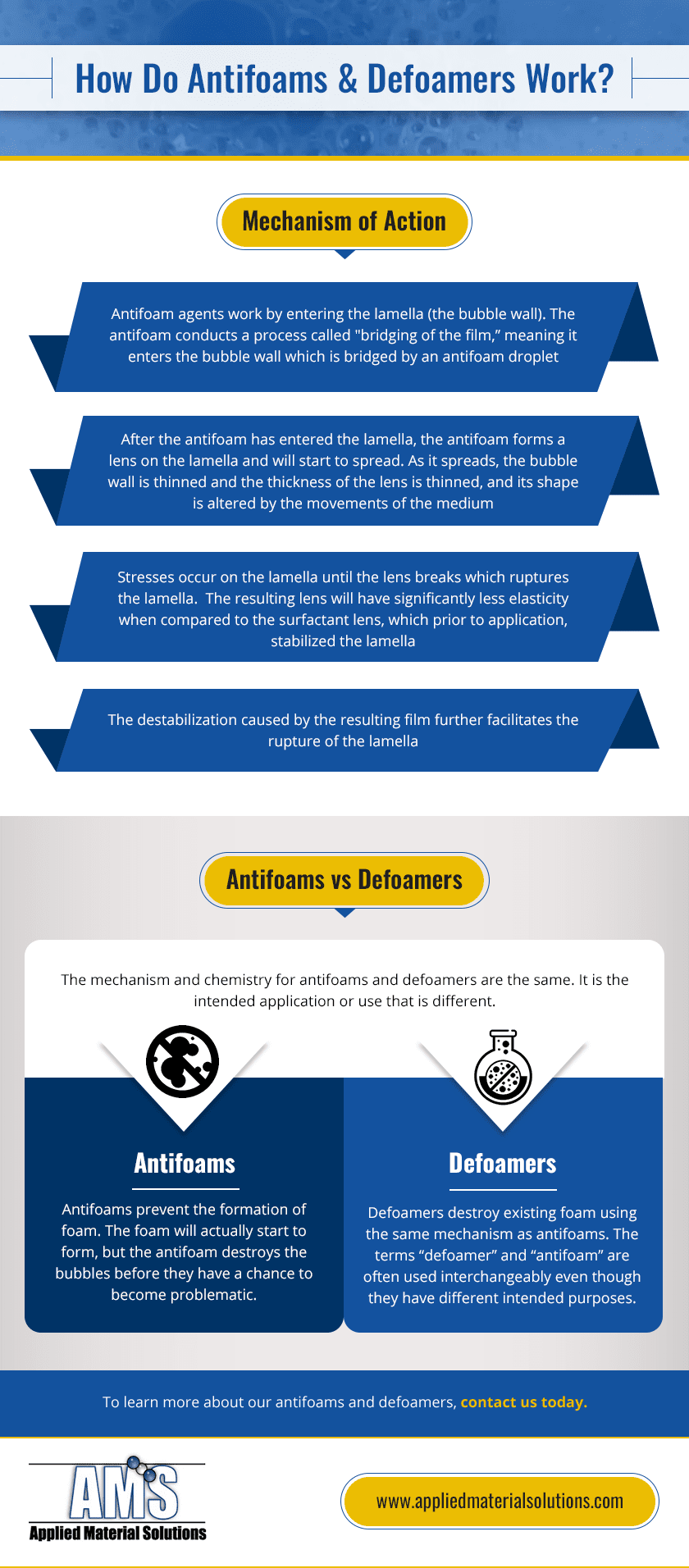Defoamers and Their Impact on Reducing Foam in Liquid Systems
Discover the Top Benefits of Making Use Of Defoamers in Industrial Processes
The usage of defoamers in commercial processes offers a series of engaging advantages that can boost operational efficiency and item top quality. By properly controlling foam production, these representatives not only enhance material flow however additionally contribute to considerable price reductions and improved sustainability. Their application extends multiple markets, which questions regarding their function in mitigating environmental influence while making certain constant result. Comprehending these advantages is essential for markets aiming to refine their procedures. The effects of adopting defoamers might be a lot more extensive than initially perceived. What certain benefits could your organization harness?
Enhanced Refine Efficiency
Enhancing industrial processes usually includes attending to lathering issues, which can prevent functional efficiency. Foam development can disrupt the appropriate functioning of equipment, lower the efficient application of sources, and complicate the tracking of important criteria. By carrying out defoamers, markets can effectively alleviate these problems, bring about streamlined procedures and enhanced productivity.
Defoamers work by destabilizing the foam structure, enabling quick collapse and considerable reduction in foam volume. This action not just improves the flow of materials via equipment, such as mixers, activators, and pipes, yet also minimizes disturbances triggered by foam overflow. Subsequently, tools downtime is reduced, permitting a more constant and efficient production procedure.
Additionally, the use of defoamers can lead to decreased energy usage. With much less foam to manage, pumps and compressors can operate more successfully, resulting in reduced functional expenses and a general enhancement in process throughput. Eventually, the strategic use defoamers not just addresses immediate foaming challenges yet additionally contributes to a more efficient commercial ecosystem, promoting a competitive benefit in a demanding market.
Improved Product High Quality
The assimilation of defoamers in commercial processes plays a vital role in improving item high quality. By effectively regulating foam formation, defoamers add to the uniformity and harmony of final items. Too much foam can cause oygenation, which adversely influences the texture and security of formulas, especially in industries such as food and finishings, pharmaceuticals, and beverages.

Furthermore, defoamers help with far better blending and diffusion of ingredients, resulting in homogeneity in formulations. This is crucial in applications where precise ingredient ratios are critical for performance and safety and security. Furthermore, the elimination of foam can decrease the danger of contamination during production, additional protecting item stability.
Eventually, by improving product high quality, defoamers not only improve consumer fulfillment yet also reinforce brand online reputation. Their duty in preserving top quality criteria underscores their importance in modern commercial processes.
Price Decrease Advantages
Executing defoamers in industrial procedures can lead to substantial cost decrease advantages. By effectively regulating foam development, defoamers minimize item loss throughout production, thereby optimizing product usage. This decrease in waste translates directly right into reduced resources costs, improving total functional efficiency.
Furthermore, making use of defoamers can reduce power intake. Extreme foam can prevent tools performance, resulting in boosted power needs to keep production levels. By reducing foam, defoamers assist in smoother procedures, permitting equipment to run extra efficiently and decreasing energy expenditures.

Additionally, defoamers can reduce handling times. Foam can develop added difficulties that extend production cycles. By using defoamers, markets can improve their processes, leading to faster turn-around times and boosted throughput. This effectiveness not only accelerates production but also permits firms to satisfy market demands much more swiftly.

Environmental Influence Reduction
In industrial processes, making use of defoamers plays a crucial function in mitigating ecological influences related to foam generation. Foam can cause considerable operational inefficiencies, causing raised discharges and waste generation. By efficiently managing foam, defoamers assist keep process performance, consequently lowering the overall environmental impact of procedures.
In addition, extreme foam can overflow control systems, bring about spills that may pollute soil and water resources. Defoamers help minimize this risk by guaranteeing that foaming does not surpass suggested limits, advertising conformity with environmental regulations. This proactive method not Learn More Here only safeguards environments but additionally enhances the sustainability of industrial techniques.
In addition, using defoamers can decrease power consumption in different procedures. defoamers. Reducing foam formation lessens the need for extra energy-intensive measures, such as enhanced frustration or pumping, which might otherwise be needed to handle foam. The fostering of defoamers straightens with broader sustainability goals by promoting power effectiveness while minimizing the carbon footprint of industrial tasks.
Inevitably, incorporating defoamers into commercial procedures is a strategic action that sustains environmental stewardship and liable source management.
Versatility Across Industries
Across different industries, defoamers show amazing convenience, adjusting to the particular requirements of diverse applications. In the food and beverage market, as an example, defoamers are vital to preserving sites product top quality by avoiding foam development throughout handling, which can impact texture and taste. Likewise, in the pharmaceutical market, defoamers make certain the security of formulations, enhancing product efficacy and uniformity.
In the chemical manufacturing realm, defoamers facilitate smoother operations by reducing foam in reaction vessels, hence boosting return and lowering downtime. The paper and pulp sector relies upon defoamers to boost the efficiency of pulp processing and paper manufacturing, making sure optimal product stability. In addition, in wastewater treatment facilities, defoamers play a vital role in regulating foam throughout aeration procedures, leading to better treatment end results.
The versatility of defoamers expands to the oil and gas sector, where they assist in handling foam in exploration fluids and manufacturing processes. By customizing solutions to meet particular sector needs, defoamers act as crucial tools that boost operational efficiency, product quality, and general procedure efficiency throughout a plethora of markets. Their adaptability highlights their value in modern-day industrial applications.
Conclusion
To conclude, the use of defoamers in commercial processes provides many benefits, including improved performance, boosted item quality, considerable cost reductions, and positive environmental influences. Their capacity to effectively manage foam formation adds to functional connection and source optimization. The adaptability of defoamers throughout varied markets underscores their essential role in promoting sustainable practices and productivity. The integration of defoamers stands for a strategic strategy to attending to difficulties related to foam administration in various making settings.
Ultimately, the strategic use of defoamers not just addresses immediate lathering obstacles but likewise adds to an extra efficient industrial environment, fostering an affordable advantage in a requiring market.
In commercial processes, the use of defoamers plays a crucial function in mitigating ecological effects linked with foam generation. By effectively controlling foam, defoamers assist preserve procedure effectiveness, consequently lowering the general ecological impact of procedures.
In addition, in wastewater treatment centers, defoamers play an essential duty in controlling foam throughout aeration procedures, leading to enhanced therapy results.
